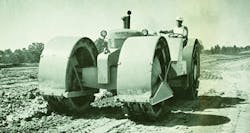As earthmoving productivity increased through mechanization and the use of mobile, free-traveling haulers instead of trains of dump cars, the need developed for high-production, efficient compaction equipment for use at the fill.
The original means of compacting earthworks was of course primitive: tamping the fill under foot or hoof, or with a ram of some sort that was wielded by hand. The first mechanized compactor was probably the smooth-drum roller, which was pulled by stock and equipped with a frame that linked the tongue, the axle and a seat on top for the operator. With the advent of tractors powerful enough to pull them, this concept evolved into the sheepsfoot roller, a drum covered with padded spikes to imitate the compacting and kneading action of the hooves of a herd of sheep being driven along the fill.
Steam rollers—actual steam-powered rollers—were developed in the late 1800s, in tandem and three-wheeled configurations. Gas and diesel power supplanted steam in the early 1900s, but the name came into such widespread use that even today’s rollers and compactors are called steam rollers in public usage. Small industrial tractors, such as those built by Fordson and McCormick-Deering, could also be converted into small rollers. As early as 1930, some Fordsons were equipped with sheepsfoot wheels on their drive axles to serve as self-propelled compactors, a move that predated a fairly common practice that started in the 1950s of converting much larger wheel tractors, especially products of Caterpillar and Euclid, into self-propelled compactors.
Three-wheeled rollers, equipped with a single steering drum in front and two drive wheels in back, provided smooth compaction across the width of the machine. In the 1930s and 1940s, three-wheeled rollers were often used for embankment compaction; in 1938 and 1939, dozens of three-wheeled rollers were the compactor of choice during grading of the Pennsylvania Turnpike. And in the 1940s and 1950s, a few tandem and three-wheel rollers were equipped with segmented drums that left a checkerboard imprint for use in compacting fill and subgrades.
In the 1940s, massive towed pneumatic rollers, traveling on a single axle with—usually—four tires, were introduced for embankment compaction. Called proofrollers, most weighed 50 tons ballasted; but at least one, used by C.J. Langenfelder at Baltimore’s Friendship Church Airport in 1947 and 1948, was ballasted to a staggering 200 tons. These rollers could be pulled behind crawler or wheel tractors, or yoked to a wheel tractor, especially a single-axle prime mover.
It wasn’t until 1954 that the first successful, purpose-built, self-propelled earth compactor was introduced. Buffalo-Springfield’s K45 Kompactor resembled a wheel tractor, but rode on four large segmented wheels. It provided high-speed compaction with superior maneuverability, but required a dozer to work with it to knock down the material to be spread. The K45 was produced into 1968, but was rendered obsolete by dozer-equipped embankment compactors that can do their own spreading; these machines entered the market in the early 1960s and have become the standard static compactor for such work today.
The Historical Construction Equipment Association (HCEA) is a 501(c)3 nonprofit organization dedicated to preserving the history of the construction, dredging and surface mining equipment industries. With more than 4,000 members in 25 countries, activities include operation of National Construction Equipment Museum and archives in Bowling Green, Ohio; publication of a quarterly magazine, Equipment Echoes, from which this text is adapted, and hosting an annual working exhibition of restored construction equipment. Individual memberships are $30 within the U.S. and Canada, and $40 elsewhere. Information is available at www.hcea.net, 419.352.5616, or [email protected].
About the Author
Tom Berry
Tom Berry is archivist for the Historical Construction Equipment Association (HCEA). Information is available at www.hcea. net, or by calling 419.352.5616 or e-mailing [email protected].
